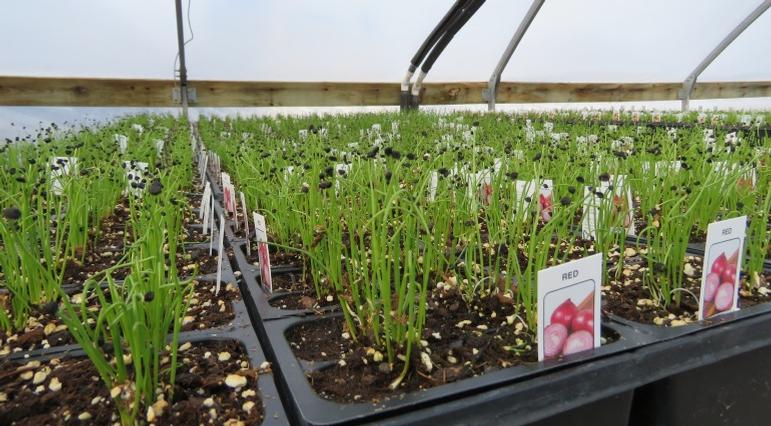Planning Your Garden

Red onion seedlings. They'll stay in the house for a few weeks before being sent outside to harden off.
A gardening plan can be a great asset to any gardening. It takes a little extra time now, but the rewards can be substantial.
Sunshine and warmer weather make us all a bit antsy for spring. If you’re like me, then you can’t wait to run out to the mailbox to see if there is another gardening catalog waiting for you! We page through them, circle the plants we need, and create lists of what we’d like to try. I’m always looking to balance the number of vegetables versus flowers that I grow!
I wandered over to the greenhouse where Mike (Timm) was planting and watched as he seeded onions and peppers. Those seed are small--one sneeze and they’re all over the greenhouse! Mike fills the trays about ¾ full of growing medium then gently spreads the seeds out on the surface. Then he sprinkles more soil on top, making sure that all the larger pieces of bark are removed so nothing inhibits the small plants’ progress toward the surface. He’s been planting for a couple of weeks already and there are many green shoots to be seen. This got me thinking about my garden and how valuable a plan can be.
Creating a solid plan now can save you time and frustration later on in the season. As a family friend used to say, “If you don’t have a plan, you can’t deviate from it.” This is especially true if you have limited space. There are various methods you can use such as computer programs (some are free and some you have to pay for), graphing paper, or you can just freehand your gardening sketch. It can be a lot of fun to sit down with your spouse, kids, or gardening friends and map out where everything will go.
Some things to consider when you’re planning for your kitchen garden:
Succession planting: radishes and many leafy greens are harvested early in the season. Some can be replanted for a second or third crop and some cannot. Consider staggering rows of plants so that as one crop is harvested, another can fill in the space.
Other variables to take into account are sunlight (full sun vs. partial sun), mature height of plant, staking and/or trellis needs, watering requirements, soil amendments and/or fertilizer, plant interaction (some plants play nicely and some don’t), and natural pest control (some plants offer some protection to your garden). This is by no means an exhaustive list, but hopefully it stimulates the creative juices and helps you get started.
There are so many resources available at the click of a button; however, we’re still the ones who have to implement the plan and get our fingers in the dirt. I cannot wait!
Have a fabulous week!
--Jake